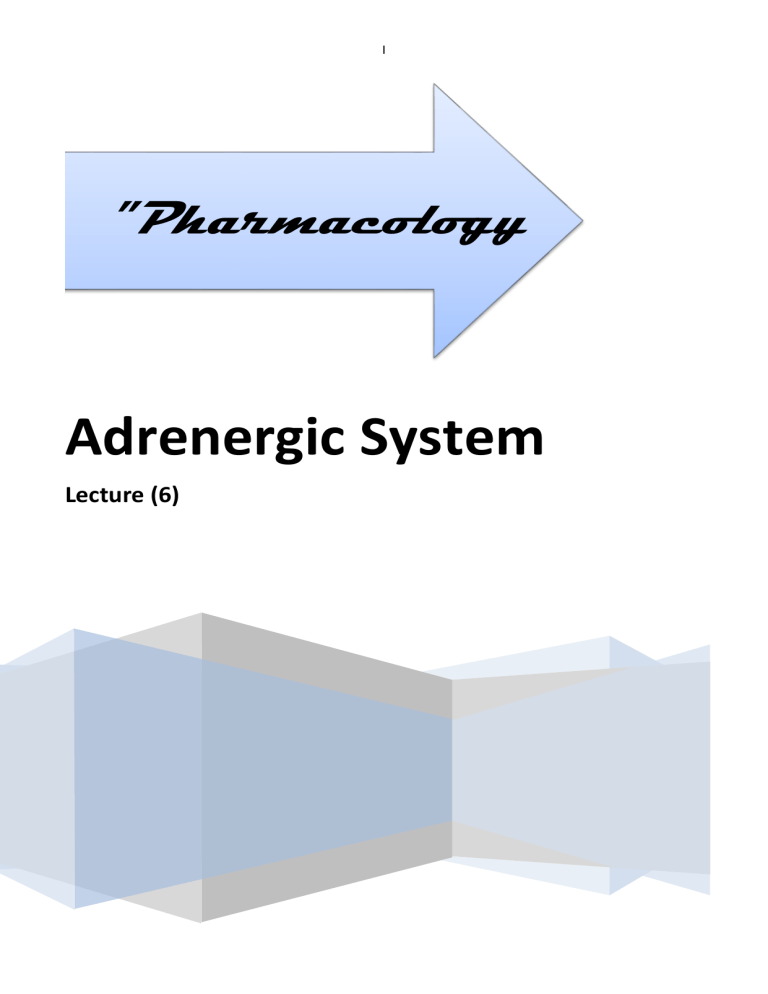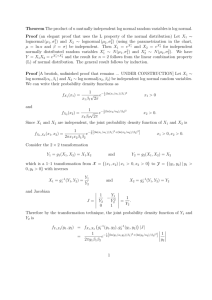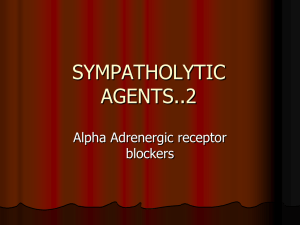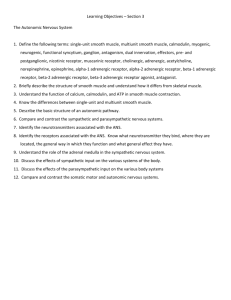lec.6

I
"Pharmacology
Adrenergic System
Lecture (6)
Adrenergic System
Classification of Beta-Blockers:
A: According to the Pharmacokinetic properties:
The solubility of beta-blockers varies, some are either lipid soluble or water soluble, others are intermediate.
1.
Lipid Soluble:
Are extensively metabolized by liver, they're subjected to extensive hepatic first pass metabolism after oral administration.
Plasma concentrations greatly between subjects (unpredictable).
They readily cross cell membranes so they have a high apparent volume of distribution (aVd).
They readily enter the CNS.
Half-life is about 3 hours.
Examples: Propranolol and Metaprolol.
2.
Water Soluble:
Excreted unchanged by the kidney.
They're less subjected to hepatic first pass metabolism.
They show more predictable plasma concentration.
These agents are less widely distributed and have lower incidence of effect attributed to penetration of CNS.
Longer half-life is around 9 hours,
Examples: Atenolol and Nadolol
B: According to selectivity:
Among beta-receptor blocking drugs, relative affinities for beta
1
and beta
2
receptor varies.
1) Non-selective blocker acts both on beta
1
and beta
2 receptors.
2) Beta
1
selective blockers (they were called Cardio-Selective Beta Blocker as scientists thought that Beta
1
receptors are present only in heart, this name is not used nowadays). These blockers have higher affinity 50-100 times for beta
1
than beta
2
receptors (this means they block beta
2
receptors).
(Examples: Atenolol, Acebutolol and Metaprolol).
Page 2
Adrenergic System
Note: there're beta
2
selective blockers but are not of big importance clinically for example: Butoxamine.
The Clinical Advantages of Selective Beta-Blockers are:
1) Diabetics: when Beta
2
receptors mediate both symptoms of hypoglycemia
(except sweating) and the counter regulatory metabolic responses that reverse the hypoglycemia.
2) Asthma: there's less likelihood of causing bronchoconstriction, however none of the available beta
1
blockers is sufficiently selective to be safely used in asthma.
3) Peripheral Vascular Disease: and when cold extremities are troublesome side effect.
Since selective beta-blockers have less effect on peripheral vascular beta
2 receptors, cold extremities are less frequent (due to decreased cardiac output with reduced peripheral blood flow).
C: According to other non-blocking effects:
1. Partial agonist action (PAA) [Intrinsic sympathetic activity] (ISA)
Most β-blocking drugs are pure antagonists (i.e. cause no activation of the receptor).
However, some are partial agonists (causing partial activation of the receptor).
This is sometimes described as having intrinsic sympathomimetic activity (ISA).
Examples: Pindolol and Acebutolol differ from pure antagonists in the following:
1) They cause less fall in resting heart rate than do the pure antagonists, and may be less effective in severe angina pectoris.
2) There are also less fall in cardiac output and possibly fewer patients experience unpleasantly cold extremities.
3) Abrupt withdrawal may be less likely to lead to a rebound effect if there is some partial agonist action, because up regulation of receptors, may not have occurred (or occur to a lesser degree).
4) They cause minimal disturbance in lipid and carbohydrate metabolism.
5) It is claimed to have increased safety in patients with airway disease.
Page 3
Adrenergic System
2. Membrane stabilizing action (MSA) [quinidine-like or local anesthetic]MSA:
It is a prominent effect of several β-blockers. This action is the result of typical local anesthetic blockage of sodium channels. These drugs are not used topically on the eye for glaucoma, where local anesthetic of the cornea would be highly undesirable e.g. Propranolol and Acebutolol.
-olol = beta blocker
Group Non-selective β-blockers
G I Oxprenolol
G II Propranolol
G III Pindolol
G IV Sotalol*
Timolol
Nadolol
Group β1-selective blockers
ISA
+
-
+
-
-
-
MSA Elimination half life
+
+
-
-
-
-
4-6 hours solubility
L.S.
L.S.
W.S.
14-24 hours W.S.
G I Acebutolol
G III Esmolol
G IV Atenolol, Nebirolol
Metoprolol, Betaxolol
Bisopsolol, Celiprolol
ISA
+
+
-
-
-
MSA Elimination half life
+
+
-
-
-
10 min
Group Combined non-selective βblockers and α1-blockers
G II Carvedilol
G IV Labetolol
Notes:
ISA
-
-
1) Nadolol has the longest elimination half life.
MSA Elimination half life
+
-
2) Esmolol has the shortest half life (about 10 minutes) so it's used during emergencies.
Solublity
W.S.
L.S. solubility
L.S.
Page 4
Adrenergic System
It belongs to the β
1
-selective blockers but now it isn’t considered as member of this group. It is used in the emergencies of arrhythmias (member of Group III of Antiarrhythmic drugs.
3) Carvedilol:
- Receptor affinity is beta
1
= beta
2
> alpha
1
> alpha
2
which means it is non selective β-blocker and also blocks α
1
receptors.
- It has clinical benefits in congestive heart failure.
- Although β-blockers are contra indicated in heart diseases but carvedilol has some benefits because it is a combined blocker.
Therapeutic uses of β-receptor blocking agent:-
A) Cardiovascular uses:
1. Angina pectoris: Beta Adrenoceptors blockers reduce the frequency of angina episode and improve exercise tolerance in many patients with angina. These actions related to decreased work and in oxygen demand.
2. Hypertension:
Β-blockers given chronically lower blood pressure in patients with hypertension.
The factors involved may include:
Reduction in cardiac output
Lowering of total peripheral resistance,
Inhibition of rennin release and perhaps
CNS effects.
For acute or emergency treatment of hypertension β-blockers are not used (may increase diastolic pressure). Labetalol, a competitive α and β antagonist, is effective so it is useful in emergency of hypertension.
3.Cardiac tachyarrhythmias:
Β-blockers are class II anti-arrhythmic. They depress automaticity and increase the
AV nodal refractory period, and they are especially effective for treatment of supraventricular arrhythmias.
Page 5
Adrenergic System
Sotalol is a non selective β-receptor antagonist that has marked class III anti arrhythmic effect reflecting potassium channel blockade. It causes lengthening the refractory period of the cardiac cells.
4.Myocardial infarction:
Β-blocker has a cardioprotective effect in:
a. Early use within 6-12 hours of infarction and for 3-4 weeks results in the reduction in the infracted size and protection against cardiac rupture.
b. Late use between 4 days-4 weeks after onset of infraction and is continue for at least 2 years. Useful for secondary prevention from another M.I (myocardial infarction).
5. Hypertrophic obstructive cardiomyopathy or (hypertrophic subaortic stenosis) and tetralogy of Fallot (TOF): β-blockers decrease outflow resistance and increase stroke volume.
6. Hepatic portal hypertension & esophageal variceal bleeding:
Βeta-blockers cause reduction of portal pressure.
7. Aortic dissection & after subarachnoid hemorrhage:
Βeta-blockers reduce force and speed of systolic ejection (contractility) and blood pressure.
B) Endocrine uses:
1.
Hyperthyroidism:
Beta-blockers reduce the unpleasant symptoms of sympathetic over-activity. There may be also an effect on the metabolism of thyroxin.
2.
Pheochromocytoma: Tumor of Chromaffin cells of Adrenal Medulla
Increased Adrenaline.
Beta-blockers may be required after α receptor blockade has been instituted to reverse the cardiac effect of excessive catecholamine.
Page 6
Adrenergic System
Beta-antagonist should not be used to establish effective α receptor blockade. Since unopposed beta receptor blockade could cause blood pressure elevation from increase vasoconstriction.
C) CNS uses:
1. Anxiety with somatic symptoms.
2. Essential tremor: tremor may respond to standard doses of selective or nonselective blockers. Dysfunction of β1 receptor has been implicated in some cases.
3. Migraine headache prophylaxis: some β-blockers e.g. Propranolol show a beneficial effect in reducing frequency and intensity of Migraine effect, the mechanism is not known.
4. Alcohol and opioids acute with drawl symptoms.
D) Eye uses:
Glaucoma: topical administration of β-blocking drug with no MSA e.g. Timolol decrease intraocular pressure (IOP), the mechanism appears to involve reduced production of aqueous humor by ciliary body.
Adverse effect of β-receptor blocking drugs:
A.
Adverse reaction due to beta-Adrenoceptors block:
1.
Cardiac failure:
B-blockade depresses myocardial contractility. In patients with abnormal myocardial functions, cardiac output may be dependent on sympathetic derive. So if this stimulus is removed cardiac decompensation may result.
2.
Bronchoconstriction:
B2-blockade associated with the use of non selective agents commonly causes worsening of pre existing asthma and other forms of airway obstruction.
While B
1
- selective drugs may have less effect on airways. They are not totally selective and may precipitate asthma.
3.
Hypotension: when drug is given after myocardial infarction.
Page 7
Adrenergic System
4.
Bradycardia and heart blockage.
5.
Hypoglycemia: occur especially with non selective members in diabetes due to impairment of the normal sympathetic- mediated homeostatic mechanisms for maintaining blood glucose. i.e: the recovery from hypoglycemia is delayed.
In addition symptoms of hypoglycemia will not occur.
6.
Cold extremities: it’s due to reduced peripheral blood flow especially with non- selective drug.
*B-blockers (1) reduce cardiac output.
(2) Block peripheral vascular B2 receptor.
7.
Withdrawal phenomenon:
Abrupt withdrawal of therapy can be dangerous in angina pectoris and after myocardial infarction.
It occurs due to up regulation of B-receptors and appears to be least common with partial agonist.
8.
Intrauterine growth retardation:
B-blockers administration during pregnancy reduce placental blood flow and may retard growth of fetus. They also produce neonatal bradycardia and neonatal hypoglycemia.
9.
Hyperlipidemia:
B-blockers cause decrease of HDL over LDL ratio with is in a direction adverse coronary heart disease. These changes are minimal with parial agonist.
10.
Impotence:
Interference with sexual function is unusual but may occur.
B.
Adverse reactions not certainly due to Beta-receptor block:
1.
CNS side effect: include sedation, fatigue, nightmares and depression. Bblocker with low lipid solubility is associated with lower incidence of CNS side effect.
2.
Hyper sensitivity reaction: might cause skin rush.
3.
Oculomuco cutaneous syndrome:
It occur with chronic use of Parctolol. Its not used now.
Page 8
Adrenergic System
Contraindications:
1.
Heart failure.
2.
Asthma.
3.
Sick sinus syndrome or heart block.
4.
Bradycardia.
5.
Hypotension.
6.
Diabetes.
7.
7.Peripheral vascular disease.
Page 9



